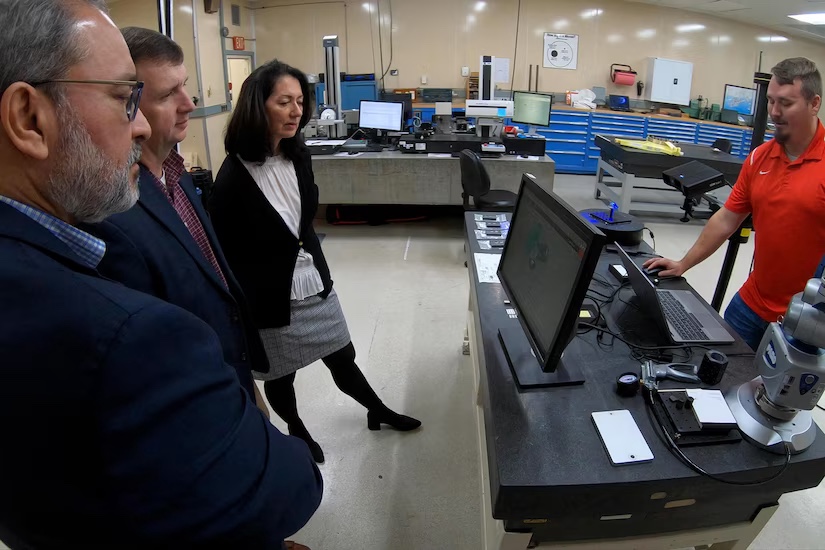The Defense Logistics Agency (DLA), a combat support agency within the U.S. Department of Defense (DoD), recently announced that the organization is developing a set of common standards and methods to streamline 3D printing for the U.S. military. Patrick Kelleher, the executive director of operations and sustainment for DLA Logistics Operations, shared this information at the Military Additive Manufacturing [AM] Summit, in Tampa, Florida (Feb. 1-2).
As one of the DoD’s eight combat support agencies, the DLA aids U.S. military services in equipment procurement and delivery, as well as in disposal of surplus and unusable supplies. Additionally, the agency assists various other departments within the U.S. federal government in distributing humanitarian aid. Beyond defining a set of standards meant to accelerate the integration of AM into military supply chains, the DLA is also focused on developing ways for different divisions within DoD to securely share AM-related data with one another.

Such data primarily includes technical information provided by suppliers that print parts for US service branches, along with a comprehensive catalog of companies that have successfully delivered 3D printed parts and raw materials to DoD. The overall effort will strengthen and expand the Joint Additive Manufacturing Model Exchange (JAMMEX), a centralized portal for US military 3D printing that was launched in January, 2020.
In a DLA press release about the development divulged at the Military AM Summit, Kelleher is quoted as saying, “DLA’s role is more clearly defined than ever, and that’s to be a facilitator and enabler of service-driven AM capabilities. We’re focused on eventually procuring AM items designated for DLA supply support. …DLA is excited for JAMMEX to continue to provide a full spectrum of support to the warfighter by reducing readiness risks, decreasing costs by providing a catalog of alternate sources for hard-to-procure and obsolete parts, and improving responsiveness.”

Finally, the DLA is working on a program that will facilitate remote inspection for 3D printed parts, which, according to Kelleher, could reduce the time required for inspection by as much as 90 percent. This means that any lead-time reductions for military supplies that are achieved with AM can be further amplified, by simultaneously yielding gradual, reciprocal decreases in inspection time.
Although the U.S. military has been pouring greater sums into the AM industry for years, macroeconomic and political conditions across the planet suggest that there will be no slowdown, any time soon. In fact, even if recent calls by policymakers to trim the defense budget are unexpectedly successful, there’s still reason to believe that AM could inversely benefit: waste-reductions in legacy manufacturing can be significantly augmented by parallel improvements of AM infrastructure.

Moreover, any money from the defense budget that gets reallocated to other agencies of the U.S. government for advanced manufacturing will still require some degree of interagency cooperation with the military, since the vast majority of government workers with advanced manufacturing experience are soldiers. This sort of “Cross-Agency Priority” will be especially crucial for agencies like the Department of Energy (DOE) and the Department of Transportation (DOT), but DoD could reasonably be expected to be involved in more or less any government project that incorporates 3D printing.
Images courtesy of DLA
Subscribe to Our Email Newsletter
Stay up-to-date on all the latest news from the 3D printing industry and receive information and offers from third party vendors.
You May Also Like
3D Printing Webinar and Event Roundup: May 5, 2024
We’ve got a busy week of 3D printing events ahead of us, in Texas, Florida, Washington, D.C., Shanghai, and more. Webinar offerings will cover medical models, PolyJet 3D printing, additive...
High Stakes, High Speed: KVG Acquires 15 Nexa3D HSE 3D Printers to Boost Military Tech
As 3D printing increasingly intersects with defense and military logistics, a new partnership between Nexa3D and mission support logistics firm KVG stresses the growing importance of this technology in strategic...
Construction 3D Printing CEO Reflects on Being Female in Construction
Natalie Wadley, CEO of ChangeMaker3D, could hear the words of her daughter sitting next to her resounding in her head. “Mum, MUM, you’ve won!” Wadley had just won the prestigious...
3D Printing News Briefs, February 17, 2024: Shot Blasting, Service Bureaus, & More
In today’s 3D Printing News Briefs, we’re starting out with post-processing, as SKZ Würzburg is using a shot blast system from AM Solutions for its research. Moving on to business,...































